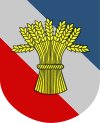National Socialist Workers' Party (Sweden)
Nationalsocialistiska Arbetarpartiet (English: National Socialist Workers' Party) was a Swedish political party which initially espoused Nazism before adopting a more indigenous form of Fascism.

The party was formed in 1933 by Sven Olof Lindholm after he split from the Swedish National Socialist Party, following a series of clashes over policy and personality. The party initially acted as a simple mirror of the National Socialist German Workers Party, with the party newspaper Den Svenske Nationalsocialisten repeating what was being said in Nazi Germany and the Nordisk Ungdom (Nordic Youth) group serving as a replica of the Hitler Youth (albeit on a smaller scale). The swastika was also initially used as the party emblem.
The NSAP did differ from the German model from the beginning however, as they placed strong emphasis on the anti-capitalist nature of their rhetoric.[1] The party's emphasis on the socialism of their Nazism led many to label them Strasserite, although they avoided the direct criticism of Adolf Hitler that was forming the bulk of the writings of Otto Strasser by the mid-1930s.

The party continued to move away from the Hitler model and largely abandoned their ties to Germany in favour of a more Swedish model. In 1938 they stopped using the swastika and replaced it with Vasakärven (the Vasa sheaf), an old Swedish emblem used by King Gustav II Adolf. By the end of the year the party had changed its name to Svensk Socialistisk Samling (Swedish Socialist Unity) and had largely dropped all but passing reference to the Nazis. Nonetheless the party declined dramatically during the Second World War and was formally dissolved in 1950.
In 1943, the party's national congress in Uppsala caused the Easter Riots to break out.
During the war its most notable member was later IKEA founder Ingvar Kamprad.[2][3][4]
The party was one of the earliest to claim that no Holocaust happened, as soon as in May 1945 in Den Svenske Folksocialisten.[5]
References
- ↑ Stanley G. Payne, A History of Fascism 1914-1945, London, Roultedge, 2001, p. 306
- ↑ Nilsson, Karl N. Alvar Svensk överklass och högerextremism under 1900-talet ISBN 91-86474-34-0 pp. 155-156
- ↑ Kamprad I, Torekull, B: "Historien om IKEA: Ingvar Kamprad berättar för Bertil Torekull", Wahlström & Widstrand, Stockholm 1998, ISBN 91-46-17065-0.
- ↑ "Kamprad djupt inblandad i nazistisk rörelse" (in Swedish). Sveriges Radio - Ekot. 23 August 2011. (Kamprad deeply involved in Nazi movement)
- ↑ Heléne Lööw, Nazismen i Sverige 1924 - 1979, ISBN 91-7324-684-0, p. 108